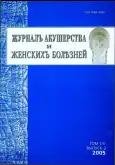Негативный опыт использования синтетического аналога соматостатина в терапии синдрома гиперстимуляции яичников
- Авторы: Гринвальд Д.В.1, Кирсанов А.А.1, Касумова А.Р.1, Бондаренко М.В.1
-
Учреждения:
- Научно—исследовательский институт акушерства, гинекологии и репродуктологии имени Д.О. Отта
- Выпуск: Том 54, № 2 (2005)
- Страницы: 40-43
- Раздел: Оригинальные исследования
- URL: https://bakhtiniada.ru/jowd/article/view/81809
- DOI: https://doi.org/10.17816/JOWD81809
- ID: 81809
Цитировать
Полный текст
Аннотация
Содержание инсулиноподобного фактора 1 (ИФР—1) в крови женщин с синдромом гиперстимуляции яичников (СГЯ) снижено, что, вероятно связано с повреждением синтетической функции печени. Использование синтетического аналога соматостатина в терапии СГЯ не приводит к достоверному положительному эффекту. Низкое содержание ИФР—1 при СГЯ делает патогенетически необоснованным использование синтетического аналога соматостатина в терапии данного синдрома.
Полный текст
Открыть статью на сайте журналаОб авторах
Д. В. Гринвальд
Научно—исследовательский институт акушерства, гинекологии и репродуктологии имени Д.О. Отта
Автор, ответственный за переписку.
Email: info@eco-vector.com
Россия, Санкт—Петербург
А. А. Кирсанов
Научно—исследовательский институт акушерства, гинекологии и репродуктологии имени Д.О. Отта
Email: info@eco-vector.com
Россия, Санкт—Петербург
А. Р. Касумова
Научно—исследовательский институт акушерства, гинекологии и репродуктологии имени Д.О. Отта
Email: info@eco-vector.com
Россия, Санкт—Петербург
М. В. Бондаренко
Научно—исследовательский институт акушерства, гинекологии и репродуктологии имени Д.О. Отта
Email: info@eco-vector.com
Россия, Санкт—Петербург
Список литературы
- Schenker J.G., Weinstein D. // Fertile Steril. — 1978. — Vol. 30.—P. 255—268.
- Delvigne A., Rosenberg S. Epidemiology and prevention of ovarian hyperstimulashion syndrome (OHSS): a review // Human Reprod. Update.—2002.—Vol. 8 (6).—P.559—577.
- Forsdahl F., Holst N., Tollan D. et al. Transcapillary fluid dynamics during ovarian stimulashion for in vitro fertilization // Am. J. Obstet. Gynecol.— 1990.—Vol. 162.—P. 554—8.
- Dominguez C.E. et al. Increased capillary permeability induced by human follicular fluid a hypothesis for an ovarian origin of the hyperstimulation syndrome (see comments) // Fertil Steril.—1995.—Vol. 63.—P. 268—72.
- Baumgardner G.P. et al. Ovarian hyperstimulashion syndrome pre—ovulatry serum concentrations of interleiukin— 6, interleukin—1, receptor antagonist and tumor necrosis factor—alfa cannot predict its occurrence // Human Reprod.—1996.—Vol. 11.—P. 1377—80.
- Abramov Y., Lewin A., Schenker J.D. et al. Plasma inflammatory cytokines correlate to the ovarian hyperstimulahaion syndrome // Human Reprod. — 1996. — Vol. 11.—P. 1381—6.
- Knox J.E. Antigistamin blockade of the ovarian hyperstimulastion syndrome // Am. J .Obstet. Gynecol. — Vol. 118.—Р. 992—4.
- Spiesil S.A., Knox G.E., Dowd A.J. et al. Antigistamine blocade of the ovarian hyperstimulahaion syndrome. II. Possible role of antigen—antibody complexes in the pathogenesis of the syndrome // Fertil. Steril.—Vol. 26.—P. 418—21.
- Gergely R.Z., Paldy E., Erlic Y. et al. Treatment of ovarian hyperstimulashion syndrome by antihistamine // Ostet. Gynecol.—1976.—Vol. 47.—P. 83—5.
- Erlic Y., Polishuk W.Z., Schencer J.G. The role of prostaglandine in ovarian hyperstimulation syndrome // Eur. J. Obstet. Gynecol. Reprod. Biol.—1976.— Vol. 6.—P. 47—52.
- Moon Y.S., Pride S.M.,Yuen B.H., et al. Relationship of gonadotropin—releasing hormone, danazol, and prostaglandin blocade to ovarian enlargement and ascites formation of the ovarian hyperstimulation syndrome in the rabbit // Am. J. Obstet. Gynecol.—1986.—Vol. 154.—P. 1155—60.
- Healy D.L., McClure N., Rogers P.A. et al. Vascular endothelial growth factor as capillary permeability agent in ovarian hyperstimulataion syndrome // Lancet.—1994. — Vol. 344.—P. 235—6.
- Berga S.L., Guzick D.S., Krasnov J.S. et al. Vascular permeability factor and vascular endothelial growth factor in ovarian hyperstimulataion syndrome: a preliminary report // Fertil. Steril.—1996.—Vol. 65.—P. 552—5.
- Abramov Y., Barac V., Nisman b.., et al. Vascular endothelial growth factor plasma levels correlate to the clinical picture in severe ovarian hyperstimulataion syndrome // Fertil. Steril.—1997.—Vol. 67.—P. 261—5.
- Christenson L.K., Lee A., Stouffer R.L. Vascular endothelial growth factor levels in serum and follicule fluid of patients undergoing in vitro fertilization // Fertil. Steril.—1997.—Vol. 68.—P. 305—1.
- MacDougall M.J., Jacobs H.S., Tan S.L. In—vitro fertilization and the ovarian hyperstimulataion syndrome // Human Reprod.—1992.—Vol. 7.—P. 597—600.
- Buyalos R.P., Lee C.T. Polycystic ovary syndrome: pathophysiology and outcome with in vitro fertilization // Fertil. Steril.—1996.—Vol. 65.—P. 1—10.
- Lidor A., Soriano D., Seidman D.S. et al. Combined somatostatin analog and follicle—stimulating hormone for women with polycystic ovary syndrome resistant to conventional treatment // Gynecol. Endocrinol.—1998.—Vol. 12 (2).—P. 97—101.
- Carmina E., Morris R.S., Vijod M.A. et al. Alterations in the sensitivity of serum insulin—like growth factor 1 and insulinlike growth factor binding protein—3 to octreotide in polycystic ovary syndrome // Fertil. Steril.—1995.—Vol. 63 (4).—p. 742—6.
- de Boer J.A., Hompes P.G., van der Meer M. et al. Octreotide, a somatostain analogue, alters ovarian sensitivity to gonadotrophin stimulation as measured by the follicle stimulation hormone threshold in polycystic ovary syndro—me // Human Reprod. — 1998. — Vol. 13(6).—P. 1465—9.
- Denburg M.R., Manibo A.M., Silfen M.E. et al. Early endocrine, metabolic and sonographic characteristics of polycystic ovary syndrome (PCOS): comparison between nonobese and obese adolescents // Clin. Endocrinol. Metab.—2003.—Vol. 88(10).—P. 4682—8.
- Dragojevic S., Prorocic M., Vasiljevic M. et al. The role of insulin—like growth—factor binding proteins in normal and polycystic ovaries // Srp. Arh. Celoc. Leс. —1998. — Vol. 126 (11—12).—P. 488.
- Iwashita M., Mimuro T., Watanabe M. et al. Plasma level of insulin—like growth factor 1 and its binding protein in polycystic ovary syndrome // Horm. Res.—1990.—Vol. 33.—P. 21—6.
- Gordana M., Prevelic M.I., Wurzburger et al. Effects of the Somatostatin Analogue, Octreotide, in polycystic ovary syndrome. // Metabolizm. — 1992.— Vol. 41.— P. 76—79.
- Morris R.S., Vishvanath C., Karande et al. Octreotida is not useful for clomiphene citrate resistance in patients with polycystic ovary syndrome but may reduce the likelihood of ovarian hyperstimulation syndrome // Fertil. Steril. — 1999. — Vol. 71(3).—P. 452—456.
- Shenker J.G. Ovarian hyperstimulation syndrome // In: Reproductive Medicine and Surgery.— 1995. — P. 650_679
Дополнительные файлы






